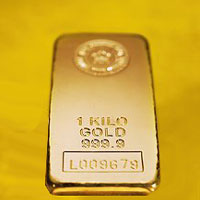Gold
Gold Alloys
Generally, the basic metals added to pure gold, are silver and copper. Once made into an alloy, gold is
known by its karat purity, with which many people are familiar: 10k, 14k, 18k, or 22k. Pure gold is 24
karat. The closer the number is to 24k, the higher the gold content.
Gold color may also be controlled through alloying. Pure (24 karat) gold is a deep yellow color (an
orange shade of yellow) and is soft and very malleable. The colored karat gold alloys range in gold
content from 8 to 22 karats (33.3% at 91.6% gold). 14 to 22 karats in the US and can be obtained in
a range of color shades: green (actually greenish-yellow), pale yellow, yellow, deep yellow, pink/rose,
red, and even purple.
Apart from copper, all other alloying metals will tend to whiten the gold color to produce 'white' gold.
Adding white metals to gold will bleach its color. In practice, nickel and palladium (and also platinum)
are strong bleachers of gold; silver and zinc are moderate bleachers, and all others are moderate or weak
in effect.
All alloys have different mechanical properties such as strength, hardness and malleability (ductility)
and some alloys may be heat-treated to maximize strength and hardness. Zinc and silicon are added to
deoxidize the gold, iridium and cobalt refine its grain, and nickel is added for strength.
In addition to affecting its physical properties, alloying gold generally increases its strength and
hardness with some reduction in malleability.
Yellow Gold
Yellow gold is a classic. It has been a store of value for over 6000 years and is one of the oldest
metals to be fashioned by man. Gold has several qualities that have made it exceptionally valuable
throughout history. It is attractive in color and brightness, durable to the point of virtual
indestructibility, highly malleable, and usually found in nature in a comparatively pure form.
Because gold is ductile and malleable in its pure form, it must be alloyed (see above) with various
other metals to harden it and in some cases, change its color. The metals used in the alloying process
include silver, copper, nickel, zinc, tin and manganese.
White gold and platinum have improved in popularity since the early 1990s, but yellow gold will always
be in fashion. Yellow gold also makes a wonderful setting for slightly yellowish diamonds because it
tends to mask the diamond's yellowish tints. Yellow gold comes in all shades of yellow and personal
taste usually dictates which hue to choose. Lighter (greener) yellow indicates more silver alloyed
with the gold. Darker (pinker) yellow indicates more copper alloyed to the gold.
White Gold
We are often asked about white gold. What is it and why is it less expensive than platinum? White gold
is created from yellow gold by alloying it with copper, nickel, zinc, chromium, tin and/or silver. When
the U.S. government declared platinum a strategic metal at the start of World War II, white gold was
substituted because of consumer preference for platinum's neutral color.
White gold is a lot less expensive than platinum because of its high content of alloys that are cheaper
than gold. And since gold is more affordable than platinum, it is half the density of platinum and costs
less than half as much per ounce so the white gold setting ends up being a lot less expensive than the
equivalent platinum setting. However, white gold in its natural state looks slightly yellow-gray. To
give white gold its white sheen, it is often electroplated with rhodium, a white metal of the platinum
family.


